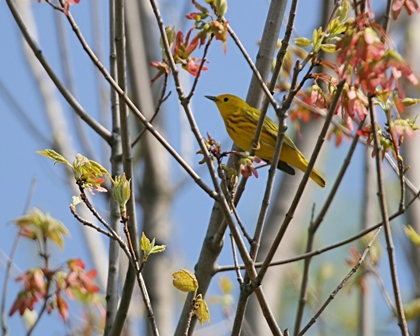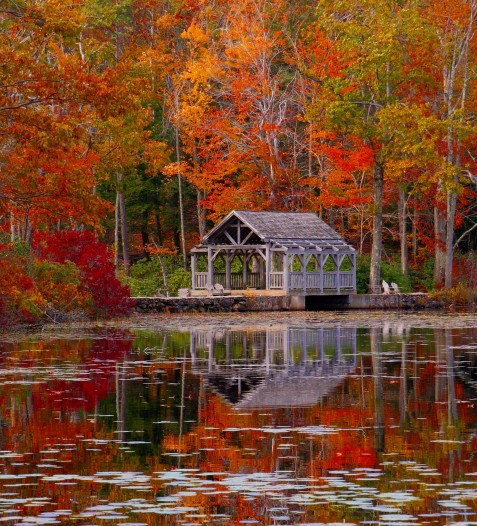 It’s the event that bird watchers around the state have been waiting for: spring migration, the time of year when birds leave their winter grounds and head north. Typically, spring migration in Massachusetts lasts from early March to early June, with the peak usually falling sometime around Mother’s Day for many species.
It’s the event that bird watchers around the state have been waiting for: spring migration, the time of year when birds leave their winter grounds and head north. Typically, spring migration in Massachusetts lasts from early March to early June, with the peak usually falling sometime around Mother’s Day for many species.
So where do in-the-know birders go to best enjoy this annual occurrence? In addition to our many and varied sanctuaries statewide, listed below are a few of Mass Audubon’s favorite birding spots.
Mt. Auburn Cemetery, Cambridge and Watertown
Why Mt. Auburn, on the border of Cambridge and Watertown, is a “migrant trap” – a sizable area of greenery within a highly-developed urbanized area. The many trees, water features, and ornamental shrubs in the cemetery offers a safe place for birds to rest, find food, and prepare for the next leg of their migratory journey.
What Songbirds, especially vireos, warblers, thrushes, and sparrows.
How This is such a popular spot that many Mass Audubon wildlife sanctuaries offer walks through Mt. Auburn during spring migration.
Parker River National Wildlife Refuge, Newbury and Newburyport
Why The extensive and varied habitats of this strategically located barrier island offer ideal stopover conditions for migrants along the coast, a pathway that many migrating birds follow in both spring and fall. The combination of salt, brackish, and freshwater wetlands as well as extensive coastal thickets attracts a wide variety of species. Birders like the area because many species are relatively easy to observe on the refuge.
What Parker River National Wildlife Refuge is attractive to a wide variety of species, but especially waterfowl, raptors, shorebirds, and warblers in late spring and early fall.
How Mass Audubon’s Joppa Flats Education Center in Newburyport runs Wednesday and Saturday morning birding programs through Parker River National Wildlife Refuge as well as other great area locations.
Daniel Webster Wildlife Sanctuary, Marshfield
Why In a state where forests grow up so quickly, and developments grow quicker still, areas of extensive grassland habitat are fairly rare especially in eastern Massachusetts. This makes Daniel Webster an important place for many grassland birds to stop during migration and also nest. It’s one of the largest regularly-maintained open grasslands in Mass Audubon’s habitat portfolio and is a popular birding destination at all times of year.
What Daniel Webster offers a fine chance to see various wetland species including waterfowl, herons, shorebirds, and swallows. Mixed flocks of blackbirds (i.e., grackles, cowbirds, red-winged blackbirds, and even the occasional rusty blackbird) as well as grassland specialties like bobolinks and eastern meadowlarks are possibilities. It’s also a favorite spot for raptors, especially open-country species like northern harriers and American kestrels.
How Explore the wildlife sanctuary on your own, or join a program offered through Mass Audubon’s North River Wildlife Sanctuary, also in Marshfield.
Scusset Beach State Reservation, Sandwich
Why The Cape Cod shoreline is often one of the first land masses that migratory birds encounter as they are moving north over the open ocean. These birds often follow the Cape Cod Bay shoreline directly to Scusset Beach State Reservation (a Department of Conservation and Recreation property), where they sometimes pause in the thickets there before turning north and continuing their migration.
What In addition to the songbirds that sometimes collect in the shrubby thickets behind the beach, seabirds like northern gannets, and sea ducks including scoters, eiders, and long-tailed ducks are regularly seen from the jetty near the mouth of the Cape Cod Canal.
How Stop by on your way to or from the Cape. Afterwards, hop back on Route 6 toward Barnstable to visit Mass Audubon’s Long Pasture Wildlife Sanctuary.
Canoe Meadows Wildlife Sanctuary, Pittsfield
Why Canoe Meadows borders the Housatonic River, a natural migration pathway, and it’s part of the Upper Housatonic Important Bird Area (IBA). The wildlife sanctuary includes a variety of habitat types including hayfields, beaver wetlands, riparian woodland, old field, and mixed woodland. Three miles of marked trails traverse these habitats.
What A wide variety of birds from waterfowl and raptors to flycatchers, warblers, and sparrows can be seen. Be on the lookout for red-breasted nuthatches, blue-gray gnatcatchers, blackburnian warblers, northern waterthrushes, and bobolinks.
How Join one of the regular Friday bird walks during April and May at Canoe Meadows, run by Mass Audubon’s Pleasant Valley Wildlife Sanctuary.
And do share in the comments: What’s your favorite spots to go birding during spring migration?


